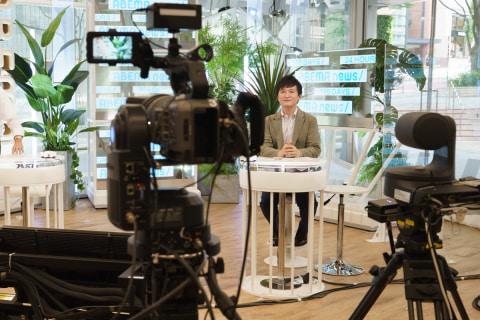Why shoot news programs with a cinema camera? “Comfortable TV” that ABEMA aims for
What is the best news program picture for smartphones?
ABEMA, which was started in cooperation with TV Asahi and CyberAgent, celebrated its 5th anniversary on April 11th. Throughout the year, a large-scale project titled "ABEMA 5th Project" is being developed, and as part of it, the news channel's shooting studio has been renewed. At that time, Sony's Cinema Line camera "FX6", which uses an E-mount and is equipped with a full-size sensor, was introduced.
Sony's Cinema Line camera "FX6"As you know, if you attach a bright lens and shoot with the aperture slightly open, you can get a bokeh image that makes the background of the person melt like a movie or portrait photo. can be taken. However, until now, I don't think anyone watching a TV news program thought, "The background of the announcer is a blur that melts away." do not have. So why did ABEMA NEWS decide to use a cinema camera for news programs?
According to TV Asahi art director and ABEMA NEWS creative director Masaru Yokoi, the background to this is the theme of “simple & stylish” that the ABEMA NEWS channel has pursued since its launch.
Mr. Masaru YokoiABEMA can be displayed from a web browser on a PC or an application installed on a TV, but most users watch it with a smartphone application. As a matter of course, smartphone screens are smaller than computer displays and TVs.

On the other hand, general news programs for television aim to "deliver a lot of information to viewers", so the amount of information on the screen is large. Mr. Yokoi, who is in charge of the design of ABEMA NEWS, said, "If you display TV news programs as they are on a smartphone with a small screen, there will be too much information and it will be difficult to see. Simple & ;Stylish image creation is a point that we are particularly particular about in this renewal.”
For example, in information variety programs, in addition to casters, commentators and guests appear. If you shoot with "pull" so that everyone is in the picture, it may not be a problem on TV, but on the small screen of a smartphone, it is difficult to see each person's face clearly, which is stressful for the viewer. In that case, for example, you can “get close” to two people or one person so that you can see the person’s expression clearly. In other words, the amount of information in the image is reduced to make it simpler.
It's not just the number of people. For example, in the case of television programs, telops appear not only at the bottom of the screen, but also at various locations such as the left, right, and center. On the screen size of a TV, it becomes a “flashy, interesting image with a lot of information”, but on a smartphone screen where small characters are difficult to read, if there is a large amount of telops, the image becomes difficult to see.
"At ABEMA, we have reduced the number of telops from the beginning, but in addition to that, we have limited the fonts that can be used and the number of colors that can be used. Terrestrial programs use various colors to make them stand out from the rest. There is a tendency to overuse it, but ABEMA doesn't need to be "too much".More importantly, it's important to create a "comfortable image" that doesn't disturb the viewer. (laughs) But instead, I pursue simple but not shabby, 'natural and comfortable images'" (Mr. Yokoi).
Tsujibo Caster actually sat in the studio. Whether it's a photo or a video, if you shoot with a bright lens, the background will be blurred and the view will be more comfortablenot. If you don't make "pictures that are easy to see on a smartphone", it will give stress to the viewer. What is interesting is that rather than pursuing a screen design that does not have negative elements, such as stress-free images, it aims to create screens that have positive elements, such as images that are comfortable to look at.
There are times when I feel that movies and travel programs are "beautiful images" and "feel good to watch", but there are not many people who feel "comfort" from the images of news programs. deaf. However, in programs such as ABEMA NEWS, which runs 24 hours a day, 365 days a year, there are many people who leave the program on for a long time, such as leaving it displayed on an app or on a browser. “Comfort” will become even more important as a news program that exists as if it were part of our daily lives.
news program recording studio







